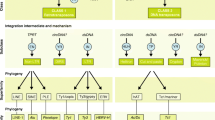Abstract
We report here that 3-aminobenzamide and other amides, such as formamide, acetamide and nicotinamide, specifically induce a high rate of transcription at the 93D puff (the hsrω heat shock gene) in polytene chromosomes of Drosophila melanogaster. Other chemicals, such as benzamide, colchicine, thiamphenicol and paracetamol, that are already known to specifically induce transcription at the hsrω locus are also identified as amides. In view of the specific induction of the 93D puff by different amides and other data that demonstrate hsrω transcription in response to benzamide and colchicine etc. to be independent of its heat shock induction, it appears likely that amides induce this locus through distinct regulatory elements that we propose to designate amide response elements (AREs).
Similar content being viewed by others
References
Behnel HJ (1982) Comparative study of protein synthesis and heat shock puffing activity in Drosophila salivary glands treated with chloramphenicol. Exp Cell Res 142: 223–228.
Choi H-S, Zheng LL, Huang LE, Liu A Y-C (1991) cAMP and cAMP dependent protein kinase regulate the human heat shock protein 70 gene promoter activity. J Biol Chem 266: 11858–11865.
Dustin P (1978) Microtubules. Springer, Berlin.
Korohoda W, Wohlfarth-Bottermann KE (1976) Effects of relaxation and contraction stimulating solutions on the structure of cytoplasm fibrils in plasmodium of Physarum polycephalum. Acta Protozool 15: 195–202.
Lakhotia SC (1987) The 93D heat shock locus in Drosophila: a review. J Genetics 66: 139–157.
Lakhotia SC, Mukherjee T (1980) Specific activation of puff 93D of D. melanogaster by benzamide and the effect of benzamide treatment on the heat shock induced puffing activity. Chromosoma 81: 125–136.
Lakhotia SC, Mukherjee T (1984) Specific induction of the 93D puff in polytene nuclei of Drosophila melanogaster by colchicine. Ind J Exp Biol 22: 67–70.
Lakhotia SC, Mutsuddi M (1996) Heat shock but not benzamide and colchicine response elements are present within the–844 bp upstream of region of the hsrω gene of Drosophila melanogaster. J Biosci 21: 235–246.
Lakhotia SC, Sharma A (1996) The 93D (hsr-omega) locus of Drosophila: non-coding gene with house-keeping functions. Genetica 97: 339–348.
Lakhotia SC, Tapadia MG (1997) Genetic mapping of the amide response element/s of the hsrω locus of Drosophila melanogaster. Submitted.
Marin R, Valet JP, Tanguay RM (1993) Hsp23 and hsp26 exhibit distinct spatial and temporal patterns of constitutive expression on Drosophila adults. Dev Genet 14: 69–77.
Morcillo G, Diez JL, Carbajal ME, Tanguay RM (1993) Hsp90 associated with specific heat shock puffs (hsrω) in polytene chromosomes of Drosophila and Chironomus. Chromosoma 102: 648–659.
Mukherjee T, Lakhotia SC (1979) 3H-thymidine incorporation in the puff 93D and in chromocentric heterochromatin of heat shocked salivary glands of D. melanogaster. Chromosoma 74: 75–82.
Mutsuddi M, Lakhotia SC (1995) Spatial expression of the hsrω (93D) gene in different tissues of Drosophila melanogaster and identification of promoter elements controlling its developmental expression. Dev Genet 17: 303–311.
Shall S, Creissen D, Tarzanch F, et al. (1984) ADP-Ribose in DNA repair and carcinogenesis. Genes and Cancer 14: 175–183.
Sims JL, Berger SJ, Berger NA (1983) Poly (ADP-ribose) polymerase inhibitors preserve nicotinamide adenine dinucleotide and adenosine 5‵-triphosphate pools in DNA damaged cells: mechanism of stimulation of unscheduled DNA synthesis. Biochemistry 22: 5188–5194.
Singh AK, Lakhotia SC (1984) Lack of effect of microtubule poisons on the 93D or 93D-like heat shock puffs in Drosophila. Ind J Exp Biol 22: 569–576.
Srivastava JP, Bangia KK (1985) Specific induction of puff 93D in the polytene chromosomes of salivary glands of Drosophila melanogaster by paracetamol. J Curr Biosci 2: 48–50.
Visvader J, Sassone-Corri P, Verma IM (1988) Two adjacent promoter elements mediate nerve growth factor activation of the C-fos gene and bind nuclear complexes. Proc Natl Acad Sci (USA) 85: 9474–9478.
Wilson SA, Wachira SJ, Drew RE, Jones D, Pearl LH (1993) Antitermination of amidase expression in Pseudomonas aeruginosa is controlled by a novel cytoplasmic amide-binding protein. EMBO J 12: 3637–3642.
Author information
Authors and Affiliations
Rights and permissions
About this article
Cite this article
Tapadia, M.G., Lakhotia, S.C. Specific induction of the hsrω locus of Drosophila melanogaster by amides. Chromosome Res 5, 359–362 (1997). https://doi.org/10.1023/A:1018440224177
Issue Date:
DOI: https://doi.org/10.1023/A:1018440224177




